After planting four straw bale gardens over five years, we decided they are not worth the annual expense and preparation hassle. So this year we are installing a raised bed of topsoil in which to plant vegetables and herbs.
We began yesterday by using our tractor to carry and dump last year's rotting bales in the nearby forest. Today Louise pulled up the landscape fabric that did little to keep weeds from growing between the rows of bales – they grew under the fabric!
We marked the outlines for the raised beds, then Mike used a 44-inch tiller attached to the tractor to till several inches into the earth within the outlines. This all sounds simple, but we worked over five hours. Here is the result.
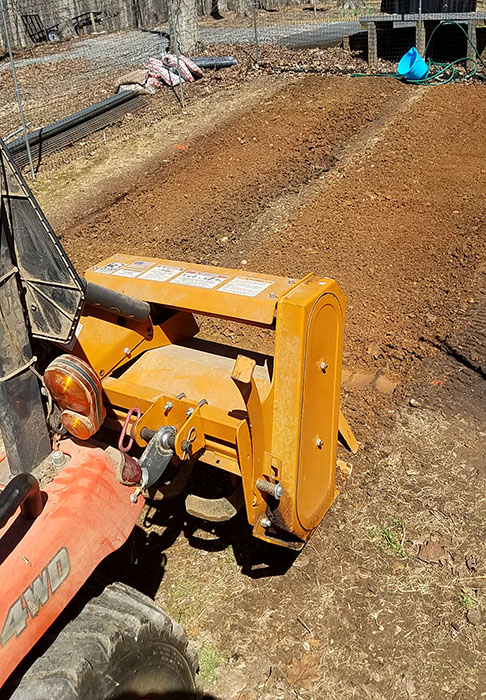
The earth finally dried out after 1½ inches of rain, so today we framed one level of Trex boards on the south bed. We're using steel corner brackets and green steel fence posts to hold the boards in place.
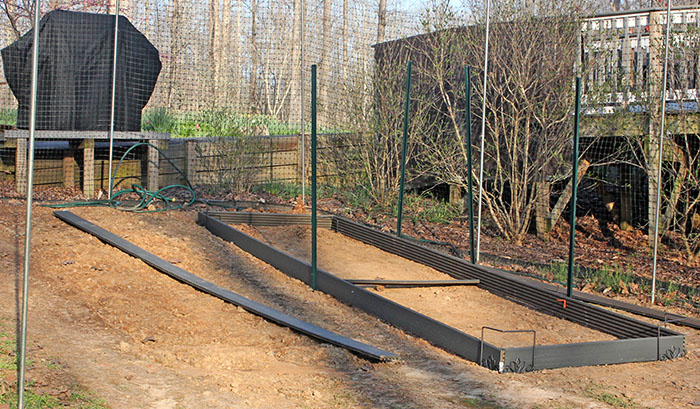
In three days, we'll take delivery of topsoil, and Mike will use the tractor to move it into the beds. He needs to approach from the side, driving over the north bed area, so we will defer building that bed until the south bed is filled.
Today we stacked the second Trex boards on the south raised bed frame. We simplified our plans to join the boards together. Orginally we'd planned to use metal joiner plates, but it turns out the board ends can be securely fastened with 2½" deck screws. Also, the boards don't flex as much as we expected, so no plates are needed in the centers, either.

Louise laid and nailed-down landcape fabric around the south bed, in the hope that it will prevent weeds from growing in the walkways. (Last year it didn't do a very good job.)
Today we received four cubic yards of composted topsoil, and Mike made about a dozen trips with the tractor to deposit half of it into the south bed. Louise used a rake to smooth and level the dirt.
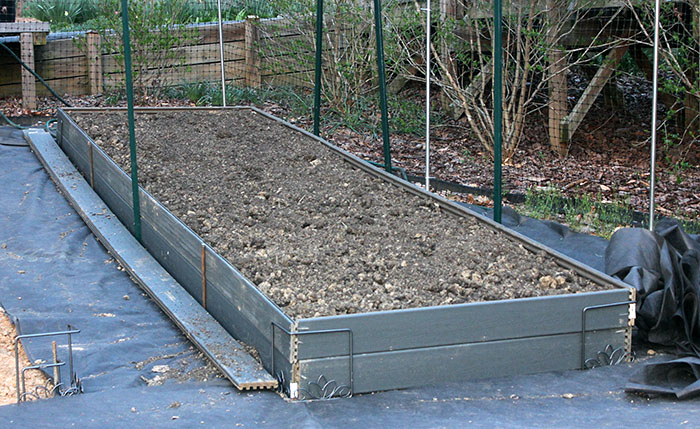
We set the bottom row of Trex boards on the north bed, then drove metal fence posts and screwed the boards to them. After that, it was fairly simple to set the top row of boards and screw them to the fence posts.
Mike used the tractor to bring the remainder of the composted topsoil to the north bed, and Louise mixed sand with it in the east half of the bed so she can grow herbs. Sadly, we ran out of soil before the north bed was filled. Maybe we'll transfer some from the south bed, or maybe what we have is enough.
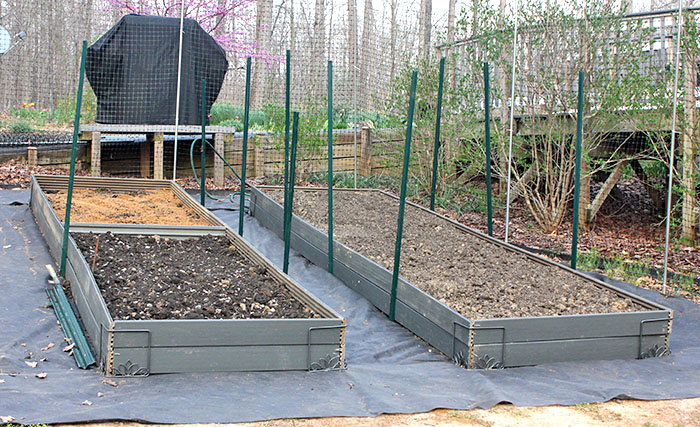
Today we laid two soaker hoses in the north bed. We bought two 50-foot hoses, which are much too long. The question was, if we cut two 16' lengths for one bed from a 50' hose, what would we use as fittings on the cut ends?
Good news! Mike discovered that the soaker hose is just the right size for standard hose-repair fittings, so he bought a femaile fitting for the upper end, and machined a Delrin plug to push into the lower end.
Mike drilled a hole for the hose in the upper end of each bed, and two holes in the divider in the center of the north bed. We cut a hose and laid the two 16-foot runs on top of the dirt in the north bed.
The soil isn't the same depth in both beds, so Louise will shovel some from the south into the north bed, covering the soaker hoses with about an inch of soil. We'll lay the south bed hoses in shallow treches, then cover them.
After all the custom cutting, we'll end up with two 18' lengths of soaker hose that we can use when these deteriorate. It will be easy to pull the fittings from the old hose and install them on the new.

Over the past several days, Mike shoveled some soil from the south bed to the north bed, to make the levels roughly equal. Louise mixed the soil with the sand in the herb-garden area of the north bed. Then she set the bedding plants and planted the seeds.
The garden is planted, and the soaker hoses are on a timer to run 30 minutes every morning. Now we wait for things to grow.

We planted herbs (rosemary bush, sage, oregano, basil, cilantro), tomatoes, cabbage, pole beans, Italian beans, pea pods, okra, bell peppers, jalapeno peppers, leeks, cucumbers, cantaloupe, butternut squash, eggplant, zucchini, and watermelon.
This is a lot to be planted in the two beds, but we'll string trellises between the side fence posts so the vines can grow upward instead of sprawling over the ground.
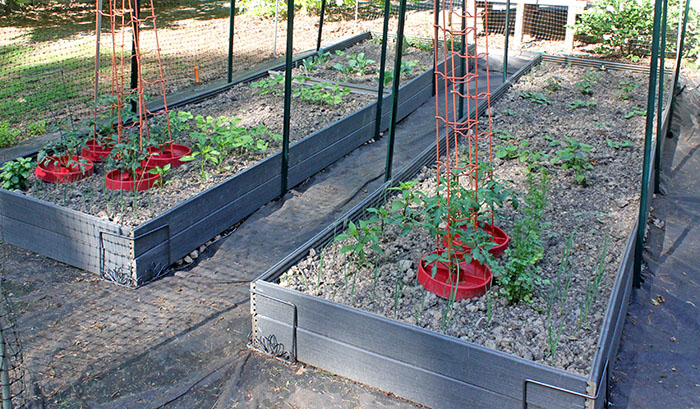
Today we finally got around to stringing polyester parachute cord ("paracord") between the green fence posts to give the plants a place to climb. It will be interesting to see if they discover the strings on their own.
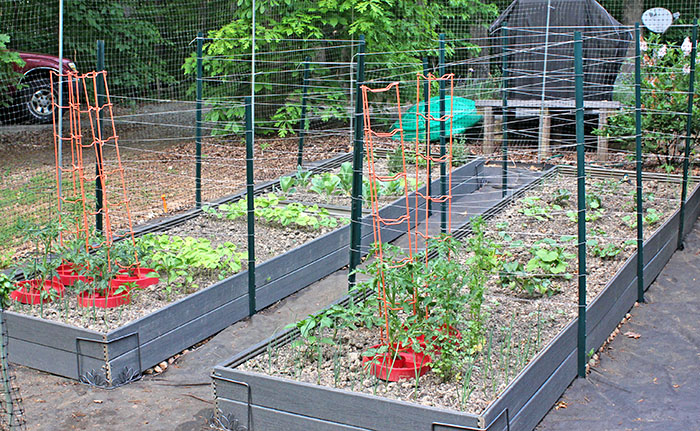
Tomato plants have produced nearly a dozen small green tomatos, so we're waiting for them to grow and ripen. Squash plants have many blossoms. Louise says there are jalapenos waiting to be turned into poppers soon. Our work is beginning to pay off.
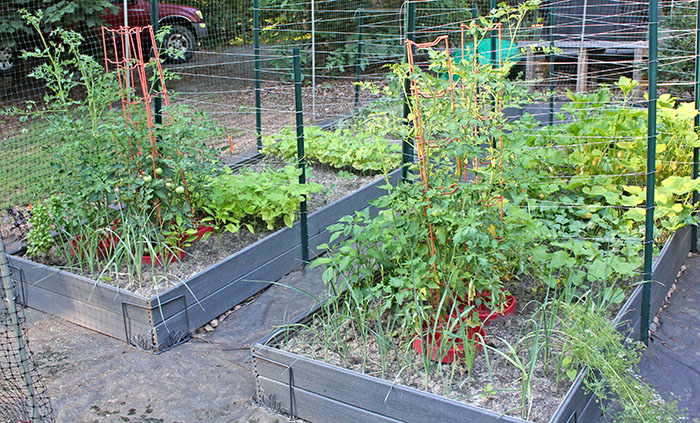
Updated May 23, 2023